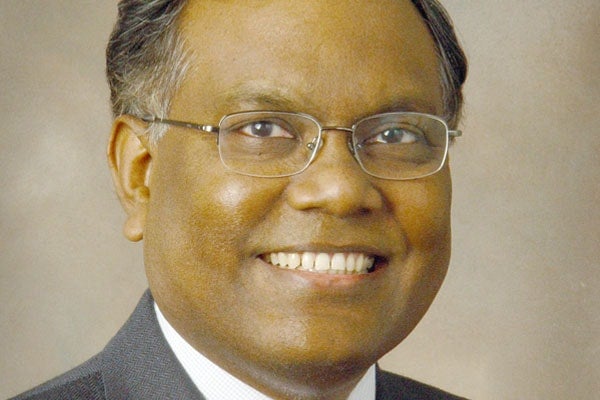
President's Teaching Awards: Chris Perumalla
Published: May 27, 2013
When it comes to teaching, Chris Perumalla is renowned for his dedication to students at the Faculty of Medicine and beyond.
An acclaimed lecturer in two flagship physiology courses and in "hands-on" laboratory courses where students get to know him personally, Perumalla is also director of the Division of Teaching Laboratories at Medicine, incorporating new research technologies to enhance the experience of undergraduate students.
In addition to his work as an undergraduate academic counselor and teaching assistant coordinator in the Physiology Department, he has helped create the Youth Summer Program for high school students interested in medicine, and developed online courses for the School of Continuing Studies.
Perumalla is one of three recipients of the 2012-2013 President’s Teaching Awards, along with Lawrence Sawchuk of the Department of Anthropology and Alissa Trotz, associate professor with the Women and Gender Studies Institute, cross-appointed to the Caribbean Studies program. (Read an interview with Trotz.)
Perumalla spoke with writer Gavin Au-Yeung about his passion for education and his commitment to his students.
How did you get into teaching?
As a graduate student and post-doctoral fellow I was really enjoying research and publishing extensively. But when I was a postdoc, I had the opportunity to work with Corey Goldman (previous PTA winner) in developing a first-year biology course at the University of Toronto. I really fell in love with teaching, designing curriculum and interacting with students. Teaching would provide me the opportunity to impact students, to cultivate in them a love for learning and to light a fire in their lives, rather than just fill their pail.
I was extremely passionate about teaching, so I had to make a hard decision of whether I would continue in basic research. But I decided that teaching was where my heart really was and that’s where I wanted to make the transition. After teaching several flagship physiology courses, and wearing the hats of Academic Counsellor and TA Coordinator in the Department of Physiology, I was appointed as the Director of Teaching Labs in Medicine in 2005; this gave me the opportunity to innovate and provide opportunities for students to use “cutting edge” technology in lab courses and embark on creating an online course.
How would you describe your teaching style?
My basic approach when teaching in a large class is to first give basic building blocks, connect them with practical life situations, and then to bring in the critical thinking and problem solving aspects to reinforce the concept. One of the ways I do this is by integrating news stories which are relevant. Students may not be thinking about physiology when they are exposed to the news, so I bring the relevance of that to the classroom – it’s very appropriate in helping students think outside the box.
What is the role of effective communication in learning?
A student coming to me for help or clarification may be intimidated if I just show off my knowledge. But if you can relate with the students it instils faith in them. Students should realize that everyone faces bumps along the road, myself included.
What have you learned from your students?
My responsibility as a teacher is to make students realize what they’re good at. There are times when I have to be brutally honest and say, “There’s no way that you are ever getting into med school… So let’s just work on plan B.” Students need to know that if plan A doesn’t work out, that doesn’t mean they have failed in life. It’s all about valuing individuals and helping them to find their career path. I’ve learned to treat every individual very differently based on where they are in life. This results in a powerful relation with my students. I’ve received hundreds of letters from former students and many still maintain contact with me.
Why is integrating teaching and research important?
Students tend to compartmentalize courses, marks, knowledge, research, their career and how much money they can make. But they have difficulties integrating what they have learned in the sciences and university environment to what’s happening in the broader world.
I would say this is a three-step approach: what is happening on the classroom, to what is happening on the research bench in a lab, to bedside delivery in a hospital. I have strived to enable students to see this connection.
Why teach at U of T?
I feel really privileged to work at an institution like the University of Toronto which maintains the balance and provides the opportunities to faculty members to be able to excel in research and teaching at the same time, while recognizing their importance and integrating both together.
Are there teachers you’ve had in the past who influenced you?
I originally come from India, and both my parents were teachers. They made a big impact on my life. Also, teaching at the university and my church on diverse topics has enabled me to exercise my gift of teaching. Furthermore, during my first year at U of T as a faculty member, I would sit in lectures and courses that I knew I’d be teaching in the future so I could learn from several amazing professors with incredible gift of communication.
What does it mean to receive the President’s Teaching Award?
I would say it’s very humbling and satisfying. U of T has given me the opportunity do what I love doing – teaching, mentoring and innovating, all geared to enhancing the educational experience of our students.



